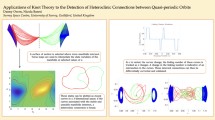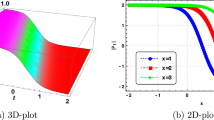Abstract
The dynamics of circumbinary planetary systems (the systems in which the planets orbit a central binary) with a small binary mass ratio discovered to date is considered. The domains of chaotic motion have been revealed in the “pericentric distance–eccentricity” plane of initial conditions for the planetary orbits through numerical experiments. Based on an analytical criterion for the chaoticity of planetary orbits in binary star systems, we have constructed theoretical curves that describe the global boundary of the chaotic zone around the central binary for each of the systems. In addition, based on Mardling’s theory describing the separate resonance “teeth” (corresponding to integer resonances between the orbital periods of a planet and the binary), we have constructed the local boundaries of chaos. Both theoretical models are shown to describe adequately the boundaries of chaos on the numerically constructed stability diagrams, suggesting that these theories are efficient in providing analytical criteria for the chaoticity of planetary orbits.
Similar content being viewed by others
References
D. Benest, Astron. Astrophys. 206, 143 (1988).
D. Benest, Astron. Astrophys. 223, 361 (1989).
D. Benest and R. Gonczi, Earth, Moon, Planets 81, 7 (1998).
D. Benest and R. Gonczi, Earth, Moon Planets 93, 175 (2004).
S. Chavez, N. Georgakarakos, S. Prodan, M. Reyes-Ruiz, H. Aceves, F. Betancourt, and E. Perez-Tijerina, Mon. Not. R. Astron. Soc. 446, 1283 (2015).
B. V. Chirikov, Phys. Rep. 52, 263 (1979).
L. Doyle, J. Carter, D. Fabrycky, R. W. Slawson, S. B. Howell, J. N. Winn, J. A. Orosz, A. Prsa, et al., Science 333, 1602 (2011).
M. J. Holman and P. A. Wiegert, Astron. J. 117, 621 (1999).
Su-Shu Huang, Publ. Astron. Soc. Pacif. 72, 106 (1960).
V. Kostov, P. R. McCullough, T. C. Hinse, Z. I. Tsvetanov, G. Hébrard, R. F. Díaz, M. Deleuil, and J. A. Valenti, Astrophys. J. 770, 52 (2013).
V. Kostov, P. R. McCullough, J. A. Carter, M. Deleuil, R. F. Díaz, D. C. Fabrycky, G. Hébrard, T. C. Hinse, et al., Astron. J. 784, 14 (2014).
A. Lichtenberg and M. Lieberman, Regular and Chaotic Dynamics (Springer, New York, 1992).
J. Lissauer, E. Quintana, J. Chambers, M. J. Duncan, and F. C. Adams, Rev.Mex. Astron.Astrophys. 22, 99 (2004).
R. Mardling, Lect. Notes Phys. 760, 59 (2008a).
R. Mardling, in Proceedings of the IAU Symposium No. 246 on Dynamical Evolution of Dense Stellar Systems, Capri, Italy, Sept. 5–9, 2007, Ed. by E. Vesperini, M. Giersz, and A. Sills (Cambridge Univ. Press, Cambridge, 2008b), p. 199.
A. V. Mel’nikov and I. I. Shevchenko, Solar Syst. Res. 32, 480 (1998).
J. Orosz, W. F. Welsh, J. A. Carter, E. Brugamyer, L.A. Buchhave, W. D. Cochran, M. Endl, E. B. Ford, et al., Astrophys. J. 758, 87 (2012).
E. A. Popova, in Proceedings of the IAU Symposium No. 310 on Complex Planetary Systems, Ed. by Z. Knezevic and A. Lemaitre (Cambridge Univ. Press, Cambridge, 2014), p. 98.
E. A. Popova and I. I. Shevchenko, Astron. Lett. 38, 581 (2012a).
E. A. Popova and I. I. Shevchenko, in Proceedings of the IAU Symposium No. 282 From Interacting Binaries to Exoplanets: Essential Modeling Tools, Ed. by M. T. Richards and I. Hubeny (Cambridge Univ. Press, Cambridge, 2012b), p. 450.
E. A. Popova and I. I. Shevchenko, Astrophys. J. 769, 152 (2013).
I. I. Shevchenko, in Asteroids, Comets, Meteors, Ed. by B. Warmbein (ESA, Berlin, 2002), p. 367.
I. I. Shevchenko, Astrophys. J. 799, 8 (2015).
I. I. Shevchenko and A. V. Mel’nikov, JETP Lett. 77, 642 (2003).
P. Thébault, F. Marzari, and H. Scholl, Mon. Not. R. Astron. Soc. 388, 1528 (2008).
P. Thébault, F. Marzari, and H. Scholl, Mon. Not. R. Astron. Soc. 393, 21 (2009).
W. Welsh et al., in Proceedings of the IAU Symposium No. 293 on Formation, Detection, and Characterization of Extrasolar Habitable Planets, August 27–31, 2012, Ed. by N. Haghighipour (2013), p. 1.
P. Wiegert and M. Holman, Astron. J. 113, 1445 (1997).
Author information
Authors and Affiliations
Corresponding author
Additional information
Original Russian Text © E.A. Popova, I.I. Shevchenko, 2016, published in Pis’ma v Astronomicheskii Zhurnal, 2016, Vol. 42, No. 7, pp. 525–532.
Rights and permissions
About this article
Cite this article
Popova, E.A., Shevchenko, I.I. On the stability of circumbinary planetary systems. Astron. Lett. 42, 474–481 (2016). https://doi.org/10.1134/S1063773716060050
Received:
Published:
Issue Date:
DOI: https://doi.org/10.1134/S1063773716060050




